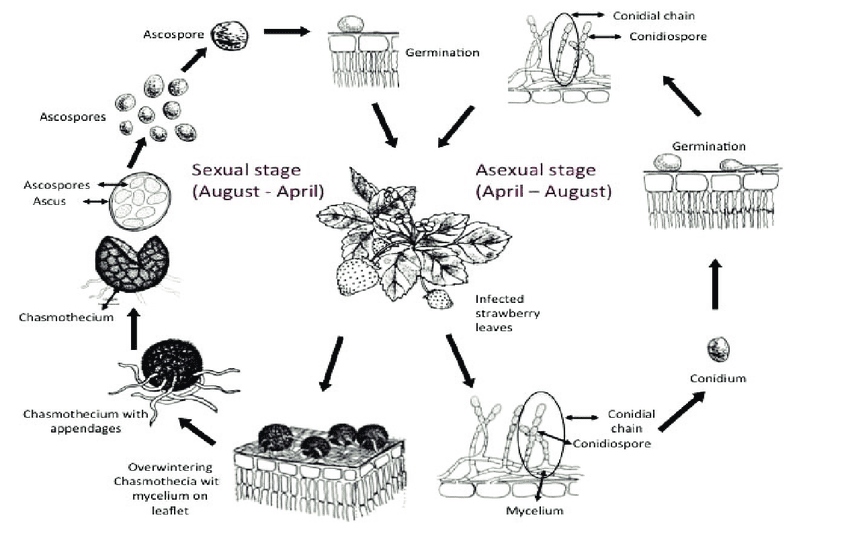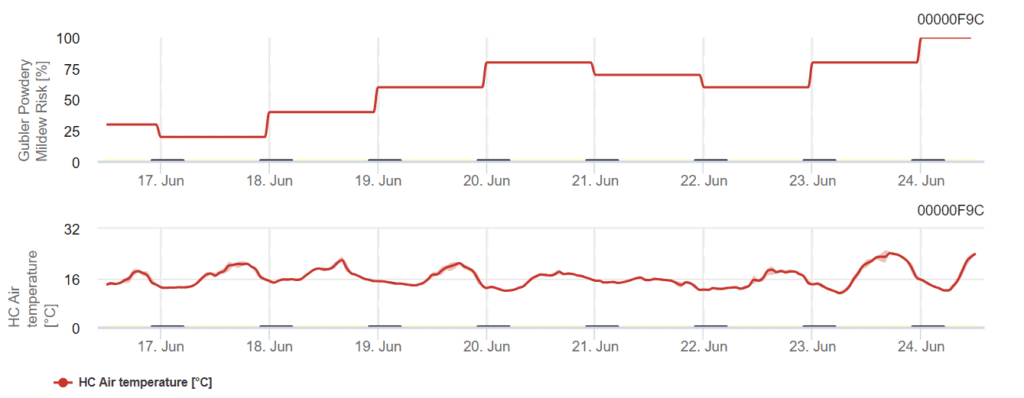
Truskawka modele choroby
Antraknoza
Patogen
Antraknoza truskawek, powodowana przez Colletotrichum acutatumobjawia się czarnymi, zapadniętymi zmianami na łodygach, pędach i owocach. Ta choroba grzybicza atakuje wszystkie części rośliny, w tym koronę, korzenie, ogonki liściowe i rozłogi.
W sprzyjających warunkach choroba może rozwijać się szybko, a nawet 90% owoców może zostać zainfekowanych w ciągu tygodnia lub krócej. Zarówno niedojrzałe, jak i dojrzałe owoce są podatne na infekcję, ale choroba jest najbardziej rozpowszechniona na dojrzewających lub w pełni dojrzałych owocach. Zainfekowane rośliny lub resztki roślinne mogą służyć jako źródło zimującego inokulum. Wiosną zarodniki są produkowane i rozprzestrzeniane przez deszcz i wiatr na stosunkowo niewielkie odległości.
Patogen wnika do rośliny przez appressorium, które penetruje naskórek i atakuje komórki naskórka. Początkowo, C. acutatum Istnieje w fazie biotroficznej i przechodzi w fazę nekrotroficzną, w której grzyb rozmnaża się w martwych komórkach. W miarę postępu choroby grzyb tworzy struktury acervuli pod ścianami komórkowymi naskórka. Te acervuli dojrzewają i uwalniają konidia, które rozprzestrzeniają chorobę szybciej, zwłaszcza pod wpływem deszczu. Wtórne konidia służą również jako istotne źródło inokulum.
Symptomy
Objawy pojawiają się najpierw w postaci więdnięcia najmłodszych liści, które mogą tymczasowo odżyć, ale wkrótce obumierają. Na liściach pojawiają się nieregularne czarne plamy, zwłaszcza na końcach liści.
Tkanka korony wykazuje wówczas czerwonawe przebarwienia, które ostatecznie stają się ciemnobrązowe lub czarne w miarę niszczenia rośliny. Zainfekowane korony są często częściowo uszkodzone, co prowadzi do zahamowania wzrostu, ale nie do całkowitego obumarcia rośliny. Zazwyczaj zainfekowana jest tylko jedna strona korony, a nie cała korona.
Ciemne, wydłużone zmiany tworzą się na ogonkach liściowych i łodygach. Zaatakowane ogonki liściowe i łodygi mogą zostać opasane przez zmiany, powodując więdnięcie i obumieranie liści lub całych roślin potomnych.
Owoce mogą zostać zainfekowane na każdym etapie rozwoju, twardniejąc i brązowiejąc. Na dojrzałych owocach rozwijają się zapadnięte, ciemne zmiany, prowadzące do mumifikacji zamiast dojrzewania. Owoce mogą również wyglądać na pokryte różowymi lub łososiowymi masami konidiów.
Model FieldClimate
Ogólny model antraknozy
Potrzebne czujniki:
- Temperatura powietrza
- Wilgotność liści
C. acutatum infekuje rośliny w zakresie temperatur od 15°C do 30°C, ale wymagany jest długotrwały okres zwilżenia liści. W optymalnych temperaturach od 20°C do 25°C konieczny jest 12-godzinny okres zwilżenia liści. Gdy wykres infekcji osiągnie wartość 100%, na polu panują optymalne warunki do infekcji.
Literatura
- Aljawasim, B. D., Samtani, J. B., & Rahman, M. (2023). Nowe spojrzenie na wykrywanie i zarządzanie chorobami antraknozy w truskawkach. Plants, 12(21), 3704.
- Ellis, M. A., & Erincik, O. (2008). Antraknoza truskawki. The Ohio State University Extension.
- Smith, B. J. (2008). Epidemiologia i patologia antraknozy truskawki: perspektywa Ameryki Północnej. HortScience, 43(1), 69-73.
Mączniak rzekomy
Patogen

Patogenem mączniaka prawdziwego truskawek jest Podosphaera aphanis. Zimuje w dwóch formach - grzybni i cleistothecia.
Zimująca grzybnia uaktywnia się wiosną, wytwarzając konidiofory, które po osiągnięciu dojrzałości uwalniają konidia (bezpłciowe zarodniki reprodukcyjne). Konidia lądują na nowej tkance, kiełkują i tworzą appressoria, wyspecjalizowane struktury infekcyjne, które penetrują komórki roślinne. Proces ten skutkuje tworzeniem się nowych kolonii.
Cleistothecia uwalnia askospory (płciowe zarodniki reprodukcyjne) od marca do maja. Askospory lądują również na nowych tkankach, kiełkują i tworzą nowe kolonie.
Zarówno grzybnia, jak i konidia służą jako pierwotne inokulum. Wtórne infekcje występują głównie poprzez konidia, które są rozpraszane przez wiatr i szybko się rozprzestrzeniają.
Gdy warunki środowiskowe stają się mniej korzystne, grzyb przestawia się na rozmnażanie płciowe - tworzenie cleistothecia - i cykl powtarza się, gdy inokulum zimuje.
Symptomy
Białe, pudrowe plamy grzybni i konidiów pojawiają się na wszystkich częściach nadziemnych i łączą się, pokrywając całą powierzchnię. Młode organy są bardziej podatne niż starsze. Jeśli chodzi o liście, wierzchnia strona wykazuje większą podatność na mączniaka niż spodnia. Silna infekcja powoduje zmniejszenie fotosyntezy, defoliację i deformację owoców. W miarę rozwoju choroby liście zwijają się ku górze, a na ich powierzchni tworzą się purpurowe lub czerwonawe plamy.
Modele FieldClimate
Broome zmodyfikował model Gublera
Potrzebne czujniki:
- Temperatura powietrza
Model opiera się na strukturze Gublera z modyfikacjami progów wysokiej temperatury wprowadzonymi przez Broome. Oblicza on ryzyko w zależności od temperatury powietrza, a wskaźnik ryzyka waha się od 0 do 100. Aby uruchomić indeks, wymagane są trzy kolejne dni z ponad 6 godzinami temperatur od 21°C do 30°C.
Indeks wzrasta o 20 punktów za każdy dzień spełniający te warunki (minimum 6 godzin w temperaturze od 21°C do 30°C). I odwrotnie, jeśli dzień trwa mniej niż 6 godzin w tym zakresie temperatur lub jeśli temperatura przekracza 35°C, indeks spada o 10 punktów.

Oryginalny model Gublera ustalił próg 35°C na 0,35 godziny, ale Broome wprowadził kilka szczegółowych progów wysokiej temperatury. Gdy określone temperatury (34°C, 36°C i 38°C) są spełnione przez wystarczający czas, punkty są odejmowane. Dodatkowo, model uwzględnia opóźnienie wzrostu grzybów; każdy wzrost indeksu w następnym dniu jest opóźniony o kilka dni, a za każdy opóźniony dzień odejmowanych jest pięć dodatkowych punktów.
Indeks poniżej 30 wskazuje na wskaźnik reprodukcji wynoszący 15 dni lub mniej, podczas gdy indeks 40 ~ 50 jest uważany za normalny, co oznacza wskaźnik reprodukcji od 8 do 11 dni. Indeks powyżej 60 wskazuje, że patogen rozmnaża się co 5 dni i zalecane jest skrócenie odstępów między opryskami.
Model mączniaka prawdziwego truskawki
Potrzebne czujniki:
- Temperatura powietrza
- Wilgotność względna
- Wilgotność liści
Model ten uwzględnia wilgotność liści i wilgotność względną w innym modelu. Temperatury powietrza powyżej 21°C i wilgotność względna powyżej 66% zwiększają ryzyko, podczas gdy niższe temperatury, wilgotność względna i wilgotność liści zmniejszają ryzyko.
Wskaźnik ryzyka poniżej 60 wskazuje na środki ochrony roślin na niskim poziomie, podczas gdy ryzyko powyżej 60 wskazuje na zwiększone ryzyko choroby i zalecane byłoby opryskiwanie. Ryzyko wystąpienia choroby na poziomie 100 przez dłuższy okres wymaga zwiększenia gęstości oprysków.
Literatura
- Broome, J. C., Hand, E. K., Backup, P., Janousek, C. N., & Gubler, W. D. (2010, czerwiec). Revising the high temperature threshold for the Gubler-Thomas grape powdery mildew risk index. In PHYTOPATHOLOGY (Vol. 100, No. 6, pp. S17-S18). 3340 PILOT KNOB ROAD, ST PAUL, MN 55121 USA: AMER PHYTOPATHOLOGICAL SOC.
- Gadoury, D. M., Asalf, B., Heidenreich, M. C., Herrero, M. L., Welser, M. J., Seem, R. C., ... & Stensvand, A. (2010). Initiation, development, and survival of cleistothecia of Podosphaera aphanis and their role in the epidemiology of strawberry powdery mildew. Phytopathology, 100(3), 246-251.
- Jin XiaoLei, J. X., Fitt, B. D. L., Hall, A. M., & Huang YongJu, H. Y. (2013). Rola chasmothecia w inicjowaniu epidemii mączniaka prawdziwego (Podospheara aphanis) i rola krzemu w kontrolowaniu epidemii na truskawce.
- Palmer, S. A. (2007). Mączniak prawdziwy truskawki: epidemiologia i wpływ odżywiania żywiciela na chorobę (rozprawa doktorska).
- Aldrighetti, A., & Pertot, I. (2023). Epidemiologia i zwalczanie mączniaka prawdziwego truskawki: przegląd. Phytopathologia Mediterranea, 62(3), 427-453.
Zalecane wyposażenie
Sprawdź, jaki zestaw czujników jest potrzebny do monitorowania potencjalnych chorób tej uprawy.
